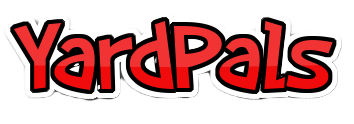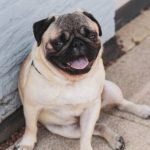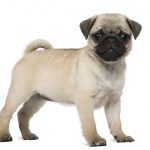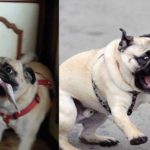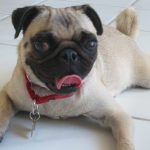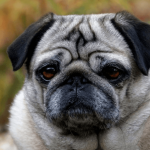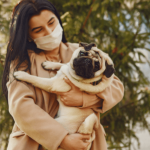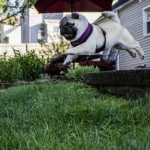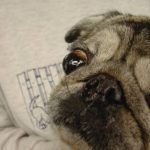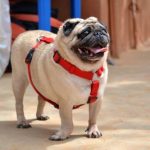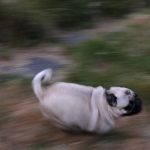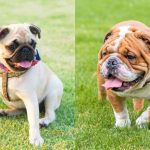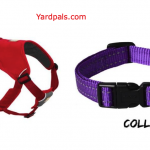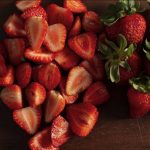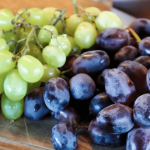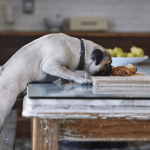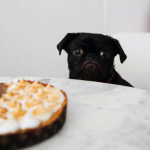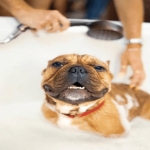Dogs
How Many Teeth Do Pugs Have? {Are you Curious to know?}
Your pug’s teeth might look small. But they can be razor-sharp. Do not misjudge them from being blunt. Pug’s teeth can cut through anything and everything. During a teething phase, your pug can be irritated. They will bite everything they can find. It’s okay for your pug to bleed when it starts teething. Pug’s teeth have a process of growth. They have a cycle of growth and fall. The periods however are very interchangeable. You might see a lot of blood drops on home items during this phase. Your dog might be miserable and can chew furniture to get some bit of relief.
Contents
- 1 Pug Teething Stages
- 2 Pug Teething Signs
- 3 How Do You Stop Your Pug From Chewing and Nipping?
- 3.1 Start teaching your pug to stop nipping (Bite inhibition)
- 3.2 Provide your pug dog chews
- 3.3 Make frozen treats for sore gums of your pug
- 3.4 Pug proof your home
- 3.5 Get your pug some exercise
- 3.6 Keep your pug excited when teething
- 3.7 Teething Toys for pugs
- 3.8 Kong classic chew toy
- 3.9 Nybalone power chew
- 3.10 Power chew dog bones
- 4 Dental Issues of Pugs
- 5 What Does a Pug’s Bite Set Look Like
- 6 Dental Care for Your Pug
- 7 Final Word!
Pug Teething Stages
Pug puppies until they are 2 weeks of age do not have proper teeth. Puppies will start having their first set of teeth after 2 weeks of age. You will see some other signs of pugs having new sets of teeth. Pugs will open their eyes at the same time.
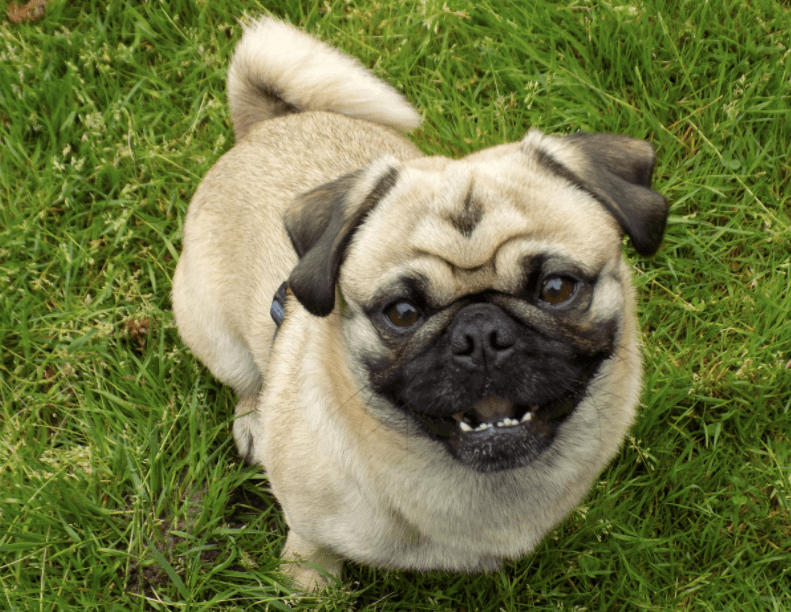
You might not see all the development. Pug puppies cannot leave their mother until they are 8 weeks old.
Pug puppy baby teeth grow (Week 2-4)
By week 4 all of your pug puppy’s baby teeth should be done growing. Pug puppies will have 28 teeth. It will also be known as baby teeth or deciduous teeth. In this stage, you cannot keep a check on the mother pug. She will be there with the breeder.
The order of pug’s teeth is as follows:
- Incisors
- Canines- Helps with eating their first solid foods
- Pre-molars- They will stop coming after 6 weeks
When a pug reaches 8 weeks of age, he must have grown all sets of his teeth.
Pug starts biting foods (Week 4-8)
This is a very crucial time for a pug. This is where a pug learns to bite solid foods. They will start to bite when learning from their siblings or their mother. It also helps the puppy develop and learn to bite from their mother. Puppies also become mature enough to learn how much strength goes into a bite?
When puppies stay with their mother and their littermates for a substantial amount of time, they learn to bite.
Pug starts to lose milk teeth (Week 8-16)
These weeks are also very crucial for pugs. They start to lose their milk teeth during this period. This period can cause a lot of spilling of blood spots. This is because your pug will chew whatever he finds during this period. It’s a good period to also let your puppy inhibit good manners.
You can also get a good toothbrush for your pooch. Make sure you start teaching your pug that you will start brushing his teeth. He should get used to these brushing habits.
Pug puppies will start the teething phase (3-6 months)
When pugs are 3 months old they lose their first set of teeth. There is an order in which your pugs can lose their temporary teeth. Do not worry these teeth will also be replaced with newer ones. This process can be painful for a pug. Your pug can start biting random things to ease the pain. During this period, give your pug something to chew. Give them toys or toy chews. It will keep the pain in check.
Pug puppy stops teething (6-8 months)
When pugs are 6-8 months old they stop teething. Pug stops teething (42 teeth worn out) when all the teeth are out. Pugs will have teeth for 6 months. They can stop when they are 8 months old. Pugs will stop teething at this age.
By now, you should have taught your pug not to chew your stuff. Imagine if a baby pug with 28 teeth can do so much damage. How much can a pug with 42 teeth do? One must wonder. There are various tricks you can incorporate to stop the chewing behaviour of your pooch.
By this time your puppy should not have any milk teeth left. If your pooch by chance has any left, please contact a vet. It is common in pugs to not go through the proper teething process at a particular age. There requires vet supervision in case there is an overlap of growth of teeth. This kind of overlap is common in brachycephalic breeds of dogs. There is nothing much to worry about, frankly speaking.
Pug Teething Signs
You might have realized by now that your pug puppy is chewing everything that he can find in your house. During the teething process, it’s very normal for your pooch to have inflamed gums. Your pug wants to soothe their gums. They do that by chewing through everything they can find in the house. It is very common for you to find toys, chew toys with bloodstains on them.
Look for these common teething signs:
- It will be a common sight for you to find baby milk teeth fallen onto the ground
- You will see bloodstains on toy chews. It is very common for you to find blood marks on toy chews and playing items.
- Teething puppies will drool. You should be expecting more saliva.
- Your pug will chew a lot of things. They will chew anything and everything they can find. Chewing provides them with a lot of relief and comfort.
- Your pug can have red inflamed gums.
- Your pug puppy can be irritated. If they are barking at you and acting naughty. It can be because they are irritated because of the pain.
- If your baby pug has a mild fever, it can be because of toothache.
How Do You Stop Your Pug From Chewing and Nipping?
When your pug puppy starts growing, they start to imprint many characteristics from others. They also start inhibiting many traits from other people. You can start training them to not chew or nip. You have to start doing everything from the start. Do it when they are impressionable.
You can start doing things to stop your pug from chewing and nipping
Start teaching your pug to stop nipping (Bite inhibition)
When your pooch is in his formative stages, he is small. Your pooch is open to learning new things. It’s easier for you to train. Pugs can be very mouthy in the following ranking stage. It should be a concerning stage as well. So, teach your pug not to bite anything he sees. He is not allowed to put everything in his mouth even if he likes. You need to start teaching your pooch some basic things.
Provide your pug dog chews
Pug puppies and adults chew for entirely different reasons. Pug puppies start to chew to keep their teeth clean. They also do that to combat frustration. But, if you look at pug puppies they chew to relieve the pain they feel when teething. Dog and toy chews are safe. These are made from tough but strong rubber for your pugs to chew upon.
However, choose a chew toy considering a pug’s age-
- Week 8 to 16: Pug puppies still have baby teeth. Your pug requires soft and baby toys to chew.
- Months 3 to 8: Your pug might start teething. It will be better if you avoid hard rubber. If your pug faces any discomfort in chewing, give them toys to chew.
- After 9 months: Once the teething phase is over, your pug can have a jaw that can cut through the rubber. You can let him focus his entire energy on playing with tug toys.
Make frozen treats for sore gums of your pug
You can provide your pug frozen treats so that they can soothe their gums. You can stuff these treats with fruits like bananas, blueberries and carrots. You can also give your pug some artificial bones to deal with their teething. If you want to try out a cheaper option just pour some ice cubes in your pug’s bowl.
Pug proof your home
You have to install some stair gates to keep some of your furniture off of the pug’s teeth. Your pug suffers from terrible pain. Pugs want to bite off dog chews and toys to get some instant relief. It is advised to not let your pugs come to rooms that might have the best furniture collection. Also, keep the stuff that you like a little above the pug’s height. This way they cannot reach it.
Get your pug some exercise
Your pug starts chewing everything when they have a lot of energy. Make sure your pooch’s energy goes down. Take your pug for a walk. Play with them. Let them run and walk in the park. They will soon sleep after so much activity. This way they won’t indulge in biting random things off of your room.
Keep your pug excited when teething
While going through the teething process, they can be sad and bored. If they are bored then give them some dog chews and play with them. Try to keep them engaged. If they are excited and happy, they will most probably forget to bite off your prized possessions.
Teething Toys for pugs
It’s important to give your pug some chew toys wherever they try to act a little mischievous. It will also fulfill a pug’s dearth of chewing. You can provide your pug something in their mouths to chew. It can save the cost of your furniture.
Kong classic chew toy
Kong’s classic chew toy is great. It’s a pouch-based chew toy. You can fill in something in its pouch and let your pug play with it. You can fill the pouch with some treats or ice treats as well. Your pug will love it. They wouldn’t be frustrated when they chew something. And they can bite into something tasty as well.
- Perfect for treats
- Recommended by top Veterinarians
- Available in many sizes
- Hollow on the inside. Can be difficult for a pug to hold in his mouth.
Nybalone power chew
The Nybalone power chew is another amazing product for your pooch. It is extremely durable and tight. Your pooch would like it because it resembles a bone. But, it’s hard to chew. This way your pug can be satisfied and get some relief from teething.
- Long-lasting chew toy
- Made from good durable material
- Bristles in the chew toy’s body. It’s good for cleaning the mouth and tartar off of your pug’s mouth.
- It satisfies the natural urge to chew.
- Made out of hard, durable material. It can make your pug more agitated.
Power chew dog bones
The Power chew bone can be a great chewing alternative for your pooch. The good thing about this bone chew is that it helps your pooch to chew as much as it wants. It tastes amazing. Your pooch will like it to chew. It can act as a perfect relief for your pooch’s teething phase. It’s hard, durable and you can chew on it till your heart’s content.
- It’s a multi-textured chewing product
- It’s a long-lasting dog chew
- Ridges and nubs prevent tartar buildup on a dog’s mouth is a perfect manner
- It has an irresistible bacon taste that a pug will love
- Intended for small dogs like pugs
- Chewing can be a bit hard because of its multiple layers.
Dental Issues of Pugs
The American Veterinary Dental Society states a dog can have a dental problem by the time they are 3. Dogs can suffer from early signs of periodontal disease. Pugs are brachycephalic dogs. They suffer from dental problems like tooth decay.
Pugs, as you know, have small mouths. They are not as big as a Labrador. Their teeth are crammed together in clusters. The teeth are not evenly spread out. There is a chance of your pug suffering from plaque. Cleaning plaque off your pooch’s teeth is hard. Plaque when not properly cleaned can easily turn into tartar and that can lead to serious infection. The infection can start from gums but then spread to the roots of your pug’s teeth.
Therefore it is important to have pet insurance for your pooch. Having pet insurance ensures that your pug can get all the medical attention it needs when they require it.
Periodontal is one such disease that your pug can suffer from. There are other diseases too that your pooch suffers from like:
- Gum disease
- Halitosis
- Bad breath
- Gingivitis
- Tooth fractures
Some warning signs that you might need to watch out for:
- Make sure your pug does not have any bad breath
- Your pug should not drool
- Your pug should not have swollen or bleeding gums
- Pug should not be losing or missing a teeth
- The tartar builds up on your pooch’s teeth and can be massive. You might even find it difficult to clean it
What Does a Pug’s Bite Set Look Like
AKC breed standards talk about bite sets being slightly undershot. This could also mean that pugs might have an underbite. Pugs lower jaws extend a bit farther than their upper jaw. Your job is to watch out so that your pug does not develop any underbite. If a pug by any chance develops any underbite take them to the vet for a proper checkup.
If problems with chewing can eventually lead to malocclusion. It can also affect the chewing process of the pugs and can also cause jaw discomfort. As far as brachycephalic dogs are concerned they have a longer lower jaw than the upper, which is also called an underbite.
Take your pooch to a vet if you see your pug developing an underbite. Pug’s bite set is however influenced by your pooch’s genetic nature. You can expect your pug’s bite set to be along similar lines. You won’t be shocked by it.
Dental Care for Your Pug
To start taking care of dental care for your pooch you need to introduce toothpaste to your pooch. Start slowly, let them taste toothpaste first. Watch if they like the taste of it. If they love the taste of the toothpaste then try brushing their teeth. You need to wash your pug’s teeth. Pugs can have accumulated plaque in their teeth that can become tar. This can make your pooch’s teeth rot in no time.
Dental care is very important for your pooch. Nowadays there are different kinds of mouth gels available for your dogs. These gels help to reduce the bacteria build-up on a pug’s mouth. Hence, it is very important to use them. It stops potential harmful diseases from spreading on a pooch’s mouth.
Final Word!
In general, the teething stages of a pug are very different. They have no teeth for 2 weeks. And then suddenly they have teeth. They have their adult teeth at 3 months after subsequent teething phases. Teething phases can be hard for a pug owner I can understand. Your pooch will be biting a lot.
You need to keep all your prized possessions in a room. Use a small gate to not allow your pooch to enter. This will not lead to your furniture being torn. Make sure you have dog chews, toys that can help your pooch to survive the teething phase. The teething phase can be extremely hard on a pug. We need to help them through this tough time.
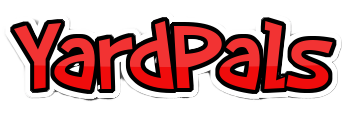
-
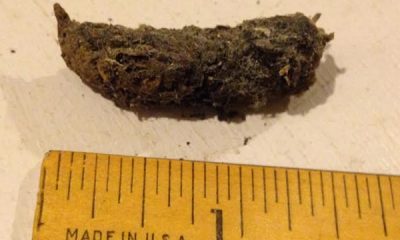
 Skunk4 years ago
Skunk4 years agoWhat Does Skunk Poop Look Like? Images & Identifications
-
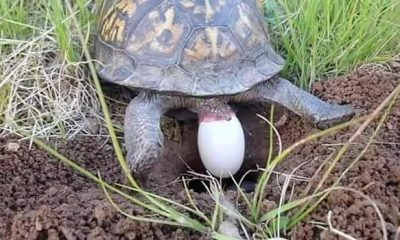
 Turtles4 years ago
Turtles4 years agoHow To Take Care of Turtle Egg At Home?
-
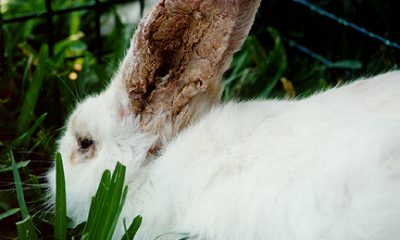
 Bunny4 years ago
Bunny4 years agoHow to Get Rid of Mites on Rabbits? #NaturalRemedies #Video
-
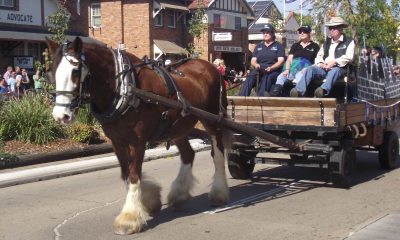
 Horse4 years ago
Horse4 years agoHow Much Weight Can a Horse Carry? #Clydesdale #Friesian #Mustang #Draft
-

 Turtles4 years ago
Turtles4 years agoHow to Take Care of Snapping Turtle Eggs? #Incubating #Hatching
-
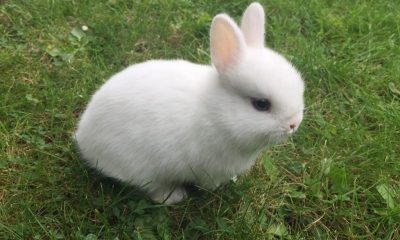
 Bunny4 years ago
Bunny4 years agoHow Big Do Dwarf Bunnies Get? – Amazing Facts #Images
-
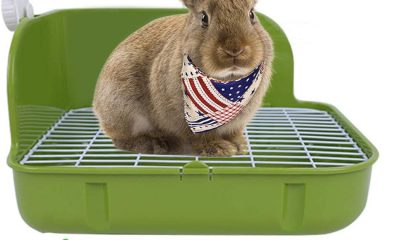
 Bunny4 years ago
Bunny4 years agoHow to Potty Train a Rabbit in House? Tips on Litter Training
-
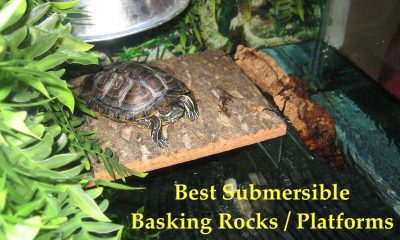
 Turtles4 years ago
Turtles4 years ago8 Basking Rocks/ Platforms for Turtles – A Perfect Guide
